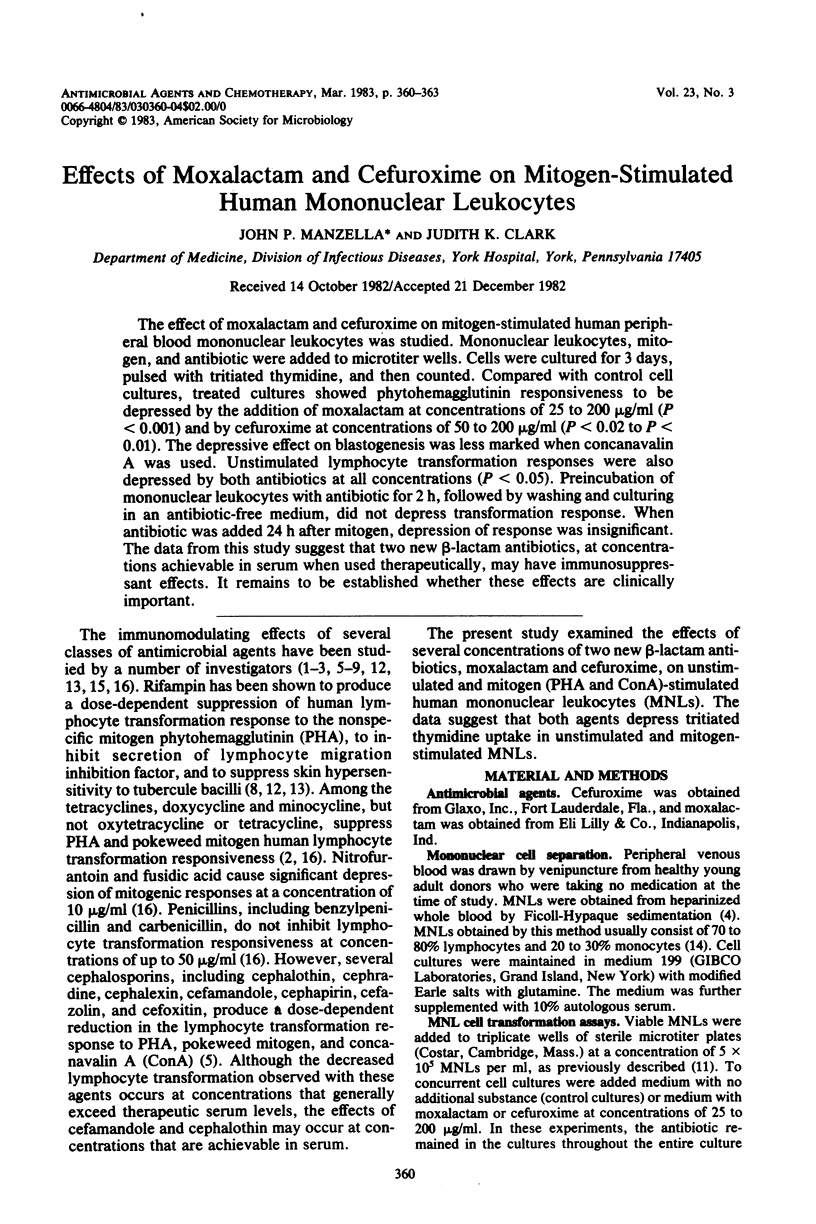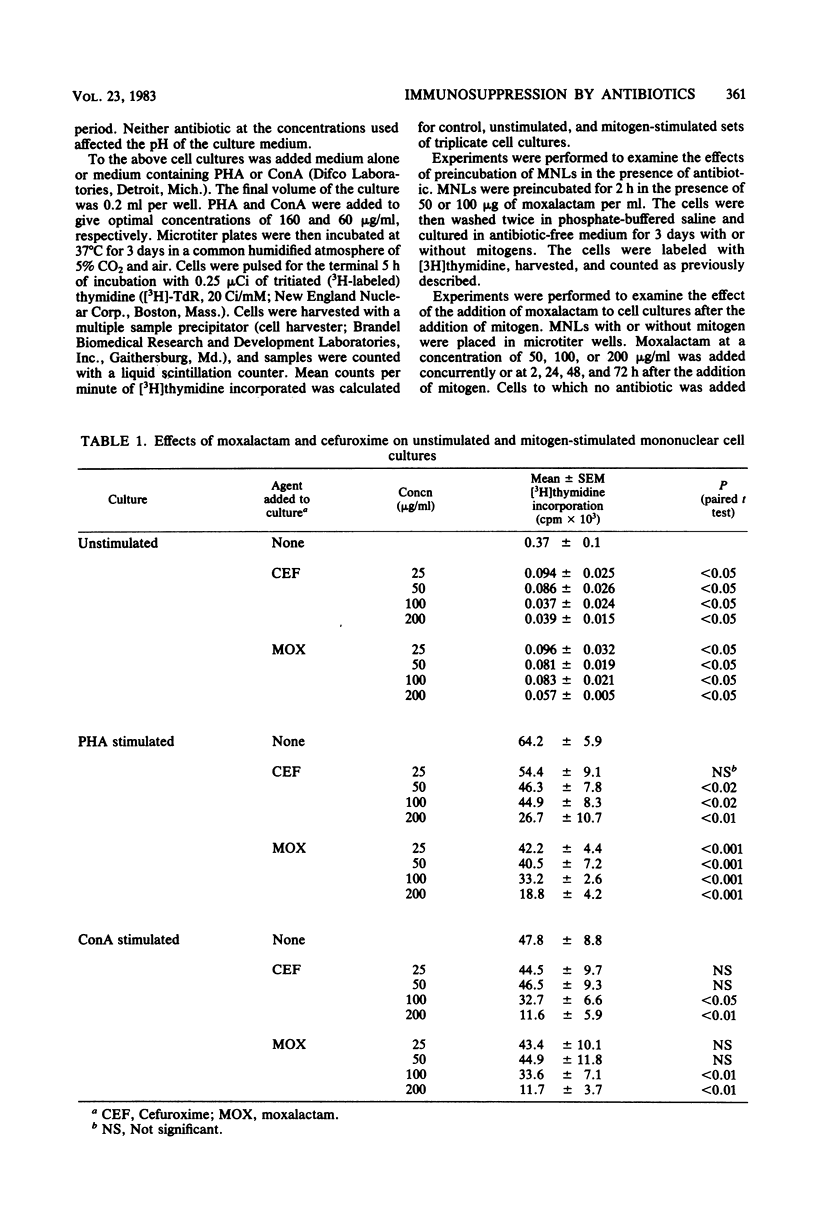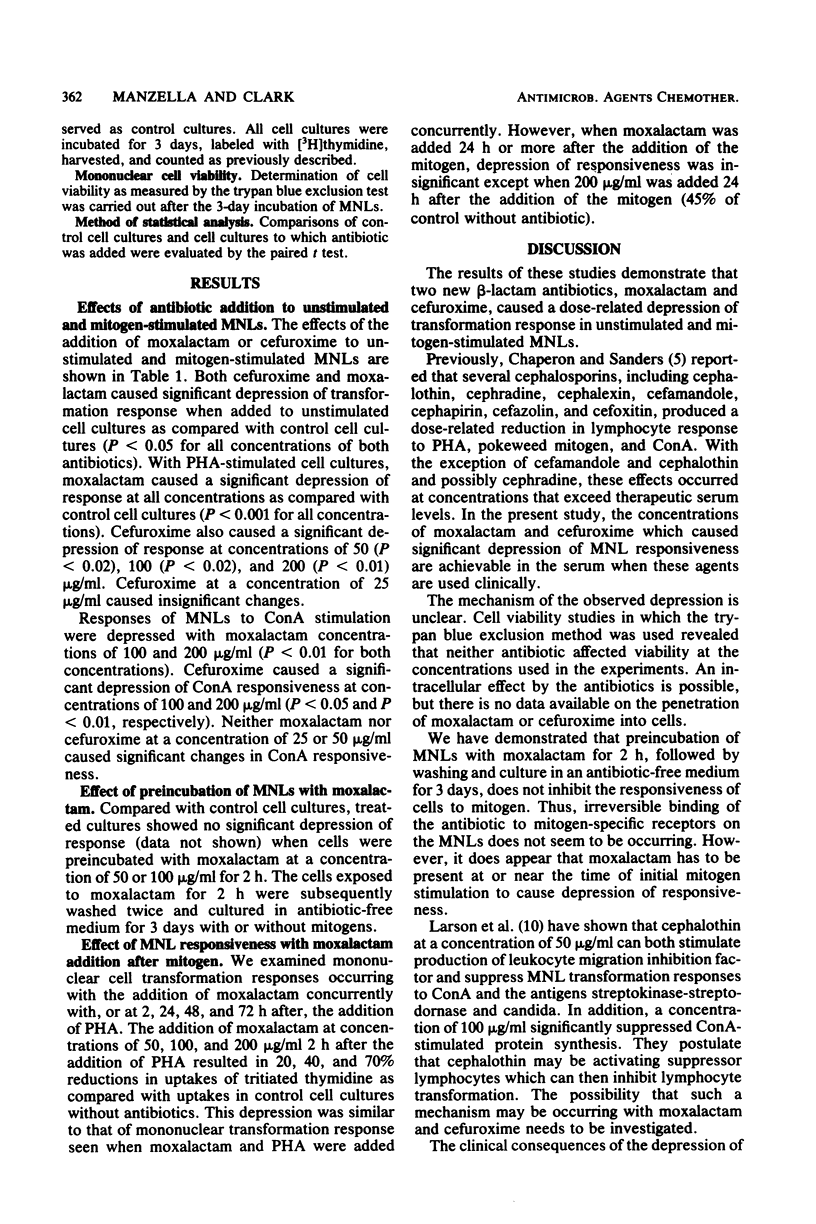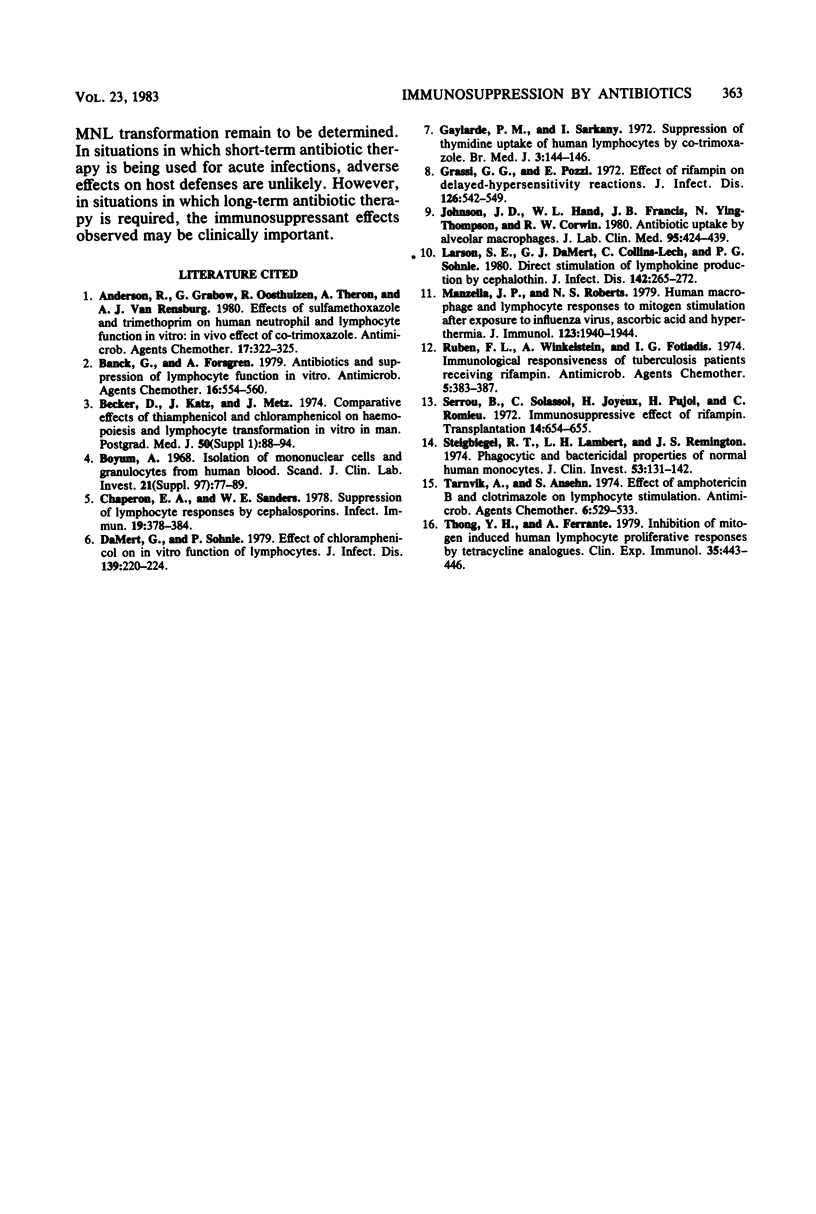Abstract
The effect of moxalactam and cefuroxime on mitogen-stimulated human peripheral blood mononuclear leukocytes was studied. Mononuclear leukocytes, mitogen, and antibiotic were added to microtiter wells. Cells were cultured for 3 days, pulsed with tritiated thymidine, and then counted. Compared with control cell cultures, treated cultures showed phytohemagglutinin responsiveness to be depressed by the addition of moxalactam at concentrations of 25 to 200 micrograms/ml (P less than 0.001) and by cefuroxime at concentrations of 50 to 200 micrograms/ml (P less than 0.02 to P less than 0.01). The depressive effect on blastogenesis was less marked when concanavalin A was used. Unstimulated lymphocyte transformation responses were also depressed by both antibiotics at all concentrations (P less than 0.05). Preincubation of mononuclear leukocytes with antibiotic for 2 h, followed by washing and culturing in an antibiotic-free medium, did not depress transformation response. When antibiotic was added 24 h after mitogen, depression of response was insignificant. The data from this study suggest that two new beta-lactam antibiotics, at concentrations achievable in serum when used therapeutically, may have immunosuppressant effects. It remains to be established whether these effects are clinically important.
Full text
PDF



Selected References
These references are in PubMed. This may not be the complete list of references from this article.
- Anderson R., Grabow G., Oosthuizen R., Theron A., Van Rensburg A. J. Effects of sulfamethoxazole and trimethoprim on human neutrophil and lymphocyte functions in vitro: in vivo effects of co-trimoxazole. Antimicrob Agents Chemother. 1980 Mar;17(3):322–326. doi: 10.1128/aac.17.3.322. [DOI] [PMC free article] [PubMed] [Google Scholar]
- Banck G., Forsgren A. Antibiotics and suppression of lymphocyte function in vitro. Antimicrob Agents Chemother. 1979 Nov;16(5):554–560. doi: 10.1128/aac.16.5.554. [DOI] [PMC free article] [PubMed] [Google Scholar]
- Burgio G. R., Keiser G., Becker D., Katz J., Metz J. Comparative effects of thiamphenicol and chloramphenicol on haemopoiesis and lymphocyte transformation in vitro in man. Postgrad Med J. 1974 Oct;50 (Suppl 5):88–94. [PubMed] [Google Scholar]
- Böyum A. Isolation of mononuclear cells and granulocytes from human blood. Isolation of monuclear cells by one centrifugation, and of granulocytes by combining centrifugation and sedimentation at 1 g. Scand J Clin Lab Invest Suppl. 1968;97:77–89. [PubMed] [Google Scholar]
- Chaperon E. A., Sanders W. E., Jr Suppression of lymphocyte responses by cephalosporins. Infect Immun. 1978 Feb;19(2):378–384. doi: 10.1128/iai.19.2.378-384.1978. [DOI] [PMC free article] [PubMed] [Google Scholar]
- DaMert G. J., Sohnle P. G. Effect of chloramphenicol on in vitro function of lymphocytes. J Infect Dis. 1979 Feb;139(2):220–224. doi: 10.1093/infdis/139.2.220. [DOI] [PubMed] [Google Scholar]
- Gaylarde P. M., Sarkany I. Suppression of thymidine uptake of human lymphocytes by co-trimoxazole. Br Med J. 1972 Jul 15;3(5819):144–146. doi: 10.1136/bmj.3.5819.144. [DOI] [PMC free article] [PubMed] [Google Scholar]
- Grassi G. G., Pozzi E. Effect of rifampicin on delayed-hypersensitivity reactions. J Infect Dis. 1972 Nov;126(5):542–544. doi: 10.1093/infdis/126.5.542. [DOI] [PubMed] [Google Scholar]
- Johnson J. D., Hand W. L., Francis J. B., King-Thompson N., Corwin R. W. Antibiotic uptake by alveolar macrophages. J Lab Clin Med. 1980 Mar;95(3):429–439. [PubMed] [Google Scholar]
- Larson S. E., DaMert G. J., Collins-Lech C., Sohnle P. G. Direct stimulation of lymphokine production by cephalothin. J Infect Dis. 1980 Aug;142(2):265–272. doi: 10.1093/infdis/142.2.265. [DOI] [PubMed] [Google Scholar]
- Manzella J. P., Roberts N. J., Jr Human macrophage and lymphocyte responses to mitogen stimulation after exposure to influenza virus, ascorbic acid, and hyperthermia. J Immunol. 1979 Nov;123(5):1940–1944. [PubMed] [Google Scholar]
- Ruben F. L., Winkelstein A., Fotiadis I. G. Immunological responsiveness of tuberculosis patients receiving rifampin. Antimicrob Agents Chemother. 1974 Apr;5(4):383–387. doi: 10.1128/aac.5.4.383. [DOI] [PMC free article] [PubMed] [Google Scholar]
- Serrou B., Solassol C., Joyeux H., Pujol H., Romieu C. Immunosuppressive effect of rifampicin. Transplantation. 1972 Nov;14(5):654–655. doi: 10.1097/00007890-197211000-00020. [DOI] [PubMed] [Google Scholar]
- Steigbigel R. T., Lambert L. H., Jr, Remington J. S. Phagocytic and bacterial properties of normal human monocytes. J Clin Invest. 1974 Jan;53(1):131–142. doi: 10.1172/JCI107531. [DOI] [PMC free article] [PubMed] [Google Scholar]
- Thong Y. H., Ferrante A. Inhibition of mitogen-induced human lymphocyte proliferative responses by tetracycline analogues. Clin Exp Immunol. 1979 Mar;35(3):443–446. [PMC free article] [PubMed] [Google Scholar]
- Tärnvik A., Ansehn S. Effect of amphotericin B and clotrimazole on lymphocyte stimulation. Antimicrob Agents Chemother. 1974 Nov;6(5):529–533. doi: 10.1128/aac.6.5.529. [DOI] [PMC free article] [PubMed] [Google Scholar]


